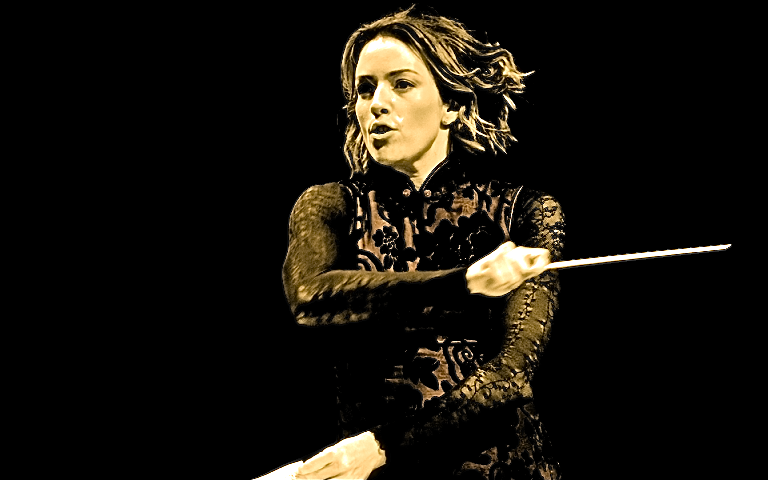I had no sense, before seeing her, of the impact Alondra de la Parra would make when she conducted the Philharmonic Orchestra of the Americas in a Dia de los muertos (Day of the Dead) concert at the Town Hall. There is an expression I heard once from a professional dancer – “making air” – that came to mind as I watched her, by which is meant the filling of the spaces of the body, as between armpit and arm, chin and sternum, the digits of hand and foot, a rib and its adjacent. She has that expanding quality, opening her body to the music and making it all but visible in the spaces that result, uncoiling, at dramatic moments, like a spring released; dropping to a tiger crouch; making taffy with hands strong and delicate.
The role of the conductor in performance can be somewhat inscrutable to me: to what extent does she (or he) direct the orchestra and to what extent the attention of the audience? It must vary according to artist and circumstance, which makes it all the more an open question. I know that you look away from de la Parra only by an act of will, or when there is some sudden or exceptional variation in the sound that she has appeared to conjure. Now and then on Saturday, in a program of deceased Mexican composers (and a dead Argentinian), the woodwinds, the harp, or the piano emerged with particular force, and so drew the eye for a moment, but otherwise it was she, of the long fingers, pliant knees, and expressive face, who crystallized the gaze, directing the aural through the arrestment of the eye.
This was true even when Natalia Lafourcade, the Mexican pop singer (whose recordings I have admired), joined her aside the podium; only once, during a particularly intense (but unidentified) number, did the pop star draw the attention as strongly as the conductor. The orchestra was the one that she founded ten years ago, as a Mexican-American in New York, at the age of twenty-four; it seems skilled and well-balanced, in both tone and talent; but has, since 2010, been in abeyance as she has worked in Europe and received praise from the likes of Placido Domingo. Most of the music played in this reunion was, as I have said, unannounced, or identified only in the moment, but it ranged from Ricardo Castro’s “Intemezzo de Atzimba” to, the sole non-Mexican composition on the program, Astor Piazzolla’s “Tangazo,” and a variety of popular and classical selections in between.
De la Parra’s treatment of the Piazzola was uncommonly moving, and revealing, too, of an exceptional sophistication. It is normal to think, in respect to an artwork, of a stripping away to the essence, chipping off marble to expose the sculpture, peeling away petals to display the mystery of the rose. What de la Parra and her orchestra did, instead, was to lay on themes and motifs that, once assembled, conjoined in a compass, creating the core by constructing its armature. This may, of course, be a function of “Tangazo” itself, and the genius of its inventor, but if so it is no small feat to have realized it so exactly, in both conception and execution. I look forward with some eagerness to the next time I am able to see de la Parra at the podium, whenever that may be, for both the dynamism of her presence and the astuteness of her art.
For information about events at the Town Hall in New York, click here.
